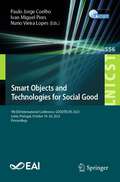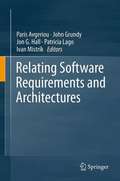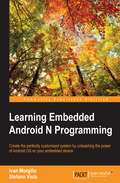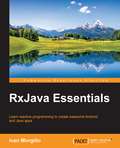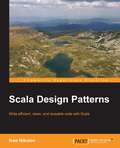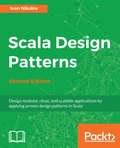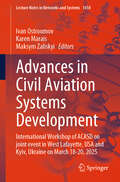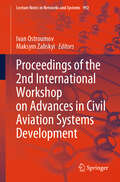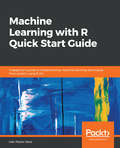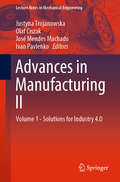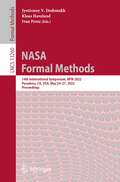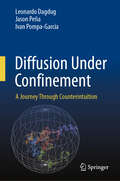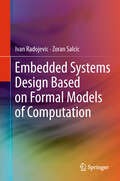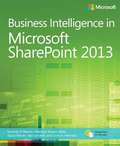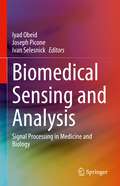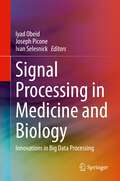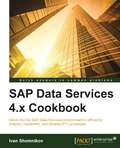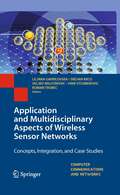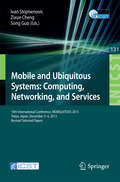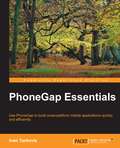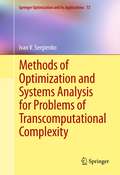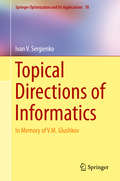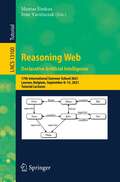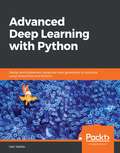- Table View
- List View
Smart Objects and Technologies for Social Good: 9th EAI International Conference, GOODTECHS 2023, Leiria, Portugal, October 18-20, 2023, Proceedings (Lecture Notes of the Institute for Computer Sciences, Social Informatics and Telecommunications Engineering #556)
by Ivan Miguel Pires Paulo Jorge Coelho Nuno Vieira LopesThis book constitutes the refereed post-conference proceedings of the 9th EAI International Conference on Smart Objects and Technologies for Social Goods, GOODTECHS 2023, held in Leiria, Portugal, during October 18-20, 2023.The 13 full papers included in this book were carefully reviewed and selected from 30 submissions. They were organized in topical sections as follows: designing, implementing, deploying, operating, and evaluating smart objects and technologies for social benefit.
Relating Software Requirements and Architectures
by John Grundy Ivan Mistrík Jon G. Hall Patricia Lago Paris AvgeriouWhy have a book about the relation between requirements and software architecture? Understanding the relation between requirements and architecture is important because the requirements, be they explicit or implicit, represent the function, whereas the architecture determines the form. While changes to a set of requirements may impact on the realization of the architecture, choices made for an architectural solution may impact on requirements, e.g., in terms of revising functional or non-functional requirements that cannot actually be met. Although research in both requirements engineering and software architecture is quite active, it is in their combination that understanding is most needed and actively sought. Presenting the current state of the art is the purpose of this book. The editors have divided the contributions into four parts: Part 1 "Theoretical Underpinnings and Reviews" addresses the issue of requirements change management in architectural design through traceability and reasoning. Part 2 "Tools and Techniques" presents approaches, tools, and techniques for bridging the gap between software requirements and architecture. Part 3 "Industrial Case Studies" then reports industrial experiences, while part 4 on "Emerging Issues" details advanced topics such as synthesizing architecture from requirements or the role of middleware in architecting for non-functional requirements. The final chapter is a conclusions chapter identifying key contributions and outstanding areas for future research and improvement of practice. The book is targeted at academic and industrial researchers in requirements engineering or software architecture. Graduate students specializing in these areas as well as advanced professionals in software development will also benefit from the results and experiences presented in this volume.
Relating Software Requirements and Architectures
by John Grundy Ivan Mistrík Jon G. Hall Patricia Lago Paris AvgeriouWhy have a book about the relation between requirements and software architecture? Understanding the relation between requirements and architecture is important because the requirements, be they explicit or implicit, represent the function, whereas the architecture determines the form. While changes to a set of requirements may impact on the realization of the architecture, choices made for an architectural solution may impact on requirements, e.g., in terms of revising functional or non-functional requirements that cannot actually be met.Although research in both requirements engineering and software architecture is quite active, it is in their combination that understanding is most needed and actively sought. Presenting the current state of the art is the purpose of this book. The editors have divided the contributions into four parts: Part 1 “Theoretical Underpinnings and Reviews” addresses the issue of requirements change management in architectural design through traceability and reasoning. Part 2 “Tools and Techniques” presents approaches, tools, and techniques for bridging the gap between software requirements and architecture. Part 3 “Industrial Case Studies” then reports industrial experiences, while part 4 on “Emerging Issues” details advanced topics such as synthesizing architecture from requirements or the role of middleware in architecting for non-functional requirements. The final chapter is a conclusions chapter identifying key contributions and outstanding areas for future research and improvement of practice.The book is targeted at academic and industrial researchers in requirements engineering or software architecture. Graduate students specializing in these areas as well as advanced professionals in software development will also benefit from the results and experiences presented in this volume.
Learning Embedded Android N Programming
by Ivan Morgillo Stefano ViolaCreate the perfectly customized system by unleashing the power of Android OS on your embedded device About This Book * Understand the system architecture and how the source code is organized * Explore the power of Android and customize the build system * Build a fully customized Android version as per your requirements Who This Book Is For If you are a Java programmer who wants to customize, build, and deploy your own Android version using embedded programming, then this book is for you. What You Will Learn * Master Android architecture and system design * Obtain source code and understand the modular organization * Customize and build your first system image for the Android emulator * Level up and build your own Android system for a real-world device * Use Android as a home automation and entertainment system * Tailor your system with optimizations and add-ons * Reach for the stars: look at the Internet of Things, entertainment, and domotics In Detail Take a deep dive into the Android build system and its customization with Learning Embedded Android Programming, written to help you master the steep learning curve of working with embedded Android. Start by exploring the basics of Android OS, discover Google's "repo" system, and discover how to retrieve AOSP source code. You'll then find out to set up the build environment and the first AOSP system. Next, learn how to customize the boot sequence with a new animation, and use an Android "kitchen" to "cook" your custom ROM. By the end of the book, you'll be able to build customized Android open source projects by developing your own set of features. Style and approach This step-by-step guide is packed with various real-world examples to help you create a fully customized Android system with the most useful features available.
RxJava Essentials
by Ivan MorgilloIf you are an experienced Java developer, reactive programming will give you a new way to approach scalability and concurrency in your backend systems, without forcing you to switch programming languages.
Scala Design Patterns
by Ivan NikolovWrite efficient, clean, and reusable code with Scala About This Book * Unleash the power of Scala and apply it in the real world * Increase your efficiency by leveraging the power of Creational, Structural, Behavioural, and Functional design patterns * Build object oriented and functional applications quickly and effectively Who This Book Is For If you want to increase your understanding of Scala and apply it to real-life application development, then this book is for you. We've also designed the book to be used as a quick reference guide while creating applications. Previous Scala programming knowledge is expected. What You Will Learn * Immerse yourself in industry-standard design patterns--structural, creational, and behavioral--to create extraordinary applications * Feel the power of traits and their application in Scala * Implement abstract and self types and build clean design patterns * Build complex entity relationships using structural design patterns * Create applications faster by applying functional design patterns In Detail Scala has become increasingly popular in many different IT sectors. The language is exceptionally feature-rich which helps developers write less code and get faster results. Design patterns make developer's lives easier by helping them write great software that is easy to maintain, runs efficiently and is valuable to the company or people concerned. You will learn about the various features of Scala and be able to apply well-known, industry-proven design patterns in your work. The book starts off by focusing on some of the most interesting features of Scala while using practical real-world examples. We will also cover the popular "Gang of Four" design patterns and show you how to incorporate functional patterns effectively. By the end of this book, you will have enough knowledge and understanding to quickly assess problems and come up with elegant solutions. Style and approach The design patterns in the book will be explained using real-world, step-by-step examples. For each design pattern, there will be hints about when to use it and when to look for something more suitable. This book can also be used as a practical guide, showing you how to leverage design patterns effectively.
Scala Design Patterns: Design modular, clean, and scalable applications by applying proven design patterns in Scala, 2nd Edition
by Ivan NikolovLearn how to write efficient, clean, and reusable code with ScalaKey FeaturesUnleash the power of Scala and apply it in the real world to build scalable and robust applications.Learn about using and implementing Creational, Structural, Behavioral, and Functional design patterns in Scala Learn how to build scalable and extendable applications efficientlyBook DescriptionDesign patterns make developers’ lives easier by helping them write great software that is easy to maintain, runs efficiently, and is valuable to the company or people concerned. You’ll learn about the various features of Scala and will be able to apply well-known, industry-proven design patterns in your work. The book starts off by focusing on some of the most interesting and latest features of Scala while using practical real-world examples. We will be learning about IDE’s and Aspect Oriented Programming. We will be looking into different components in Scala. We will also cover the popular "Gang of Four" design patterns and show you how to incorporate functional patterns effectively. The book ends with a practical example that demonstrates how the presented material can be combined in real-life applications. You’ll learn the necessary concepts to build enterprise-grade applications. By the end of this book, you’ll have enough knowledge and understanding to quickly assess problems and come up with elegant solutions.What you will learn Immerse yourself in industry-standard design patterns—structural, creational, and behavioral—to create extraordinary applications See the power of traits and their application in Scala Implement abstract and self types and build clean design patterns Build complex entity relationships using structural design patterns Create applications faster by applying functional design patternsWho this book is forIf you want to increase your understanding of Scala and apply design patterns to real-life application development, then this book is for you.Prior knowledge of Scala language is assumed/ expected.
Advances in Civil Aviation Systems Development: International Workshop of ACASD on Joint Event in West Lafayette, USA and Kyiv, Ukraine on March 18-20, 2025 (Lecture Notes in Networks and Systems #1418)
by Ivan Ostroumov Maksym Zaliskyi Karen MaraisThis book includes high-quality research papers presented at 3rd International Workshop on Advances in Civil Aviation Systems Development (ACASD 2025), which was joint event of School of Aeronautics and Astronautics of Purdue University (IN, USA) and National Aviation University (Kyiv, Ukraine). This book presents original results of a scholarly study of unique research teams and market leaders on the development in civil aviation systems and its application. The book topics include major research areas focused on advances in air transportation, interference in global navigation satellite system, aircraft noise, communication systems for civil aviation systems, surveillance data processing, methods of operational efficiency improvement, sensors in civil aviation, human factor, and unmanned aircraft systems. Book is useful for scholars and professionals in the civil aviation domain.
Proceedings of the 2nd International Workshop on Advances in Civil Aviation Systems Development (Lecture Notes in Networks and Systems #992)
by Ivan Ostroumov Maksym ZaliskyiThis book includes high-quality research papers presented at 2nd International Workshop on Advances in Civil Aviation Systems Development (ACASD 2024), which was at National Aviation University, Kyiv Ukraine, on March 26, 2024. This book presents original results of a scholarly study of unique research teams and market leaders on the development in civil aviation systems and its application. The book topics include major research areas focused on advances in air traffic management, data processing in civil aviation, automatic control in civil aviation systems, modern trends in navigation systems development, methods of operational efficiency improvement, human factor, and application of artificial intelligence in civil aviation systems. This book is useful for scholars and professionals in the civil aviation domain.
Machine Learning with R Quick Start Guide: A beginner's guide to implementing machine learning techniques from scratch using R 3.5
by Ivan Pastor SanzLearn how to use R to apply powerful machine learning methods and gain insight into real-world applications using clustering, logistic regressions, random forests, support vector machine, and more. Key Features Use R 3.5 to implement real-world examples in machine learning Implement key machine learning algorithms to understand the working mechanism of smart models Create end-to-end machine learning pipelines using modern libraries from the R ecosystem Book Description Machine Learning with R Quick Start Guide takes you on a data-driven journey that starts with the very basics of R and machine learning. It gradually builds upon core concepts so you can handle the varied complexities of data and understand each stage of the machine learning pipeline. From data collection to implementing Natural Language Processing (NLP), this book covers it all. You will implement key machine learning algorithms to understand how they are used to build smart models. You will cover tasks such as clustering, logistic regressions, random forests, support vector machines, and more. Furthermore, you will also look at more advanced aspects such as training neural networks and topic modeling. By the end of the book, you will be able to apply the concepts of machine learning, deal with data-related problems, and solve them using the powerful yet simple language that is R. What you will learn Introduce yourself to the basics of machine learning with R 3.5 Get to grips with R techniques for cleaning and preparing your data for analysis and visualize your results Learn to build predictive models with the help of various machine learning techniques Use R to visualize data spread across multiple dimensions and extract useful features Use interactive data analysis with R to get insights into data Implement supervised and unsupervised learning, and NLP using R libraries Who this book is for This book is for graduate students, aspiring data scientists, and data analysts who wish to enter the field of machine learning and are looking to implement machine learning techniques and methodologies from scratch using R 3.5. A working knowledge of the R programming language is expected.
Advances in Manufacturing II: Volume 1 - Solutions for Industry 4.0 (Lecture Notes in Mechanical Engineering)
by Olaf Ciszak Justyna Trojanowska Ivan Pavlenko José Mendes MachadoThis book covers a variety of topics related to the Industry 4.0 concept, with a special emphasis on the efficiency of production processes and innovative solutions for smart factories. It describes tools supporting this concept in both the mechanical engineering and biomedical engineering field. The content is based on papers presented at the 6th International Scientific-Technical Conference MANUFACTURING 2019, held on 19-22 May 2019, in Poznan, Poland. Virtual reality, simulation of manufacturing systems, additive manufacturing, big data analysis, automation and application of artificial intelligence, as well as economic and social issues related to the integration of those technologies are just some of the topics discussed here. All in all, the book offers a timely and practice-oriented reference guide for researchers and practitioners, and is expected to foster better communication and closer cooperation between universities and their business and industrial partners.
NASA Formal Methods: 14th International Symposium, NFM 2022, Pasadena, CA, USA, May 24–27, 2022, Proceedings (Lecture Notes in Computer Science #13260)
by Klaus Havelund Ivan Perez Jyotirmoy V. DeshmukhThis book constitutes the proceedings of the 14th International Symposium on NASA Formal Methods, NFM 2022, held in Pasadena, USA, during May 24-27, 2022. The 33 full and 6 short papers presented in this volume were carefully reviewed and selected from 118submissions. The volume also contains 6 invited papers. The papers deal with advances in formal methods, formal methods techniques, and formal methods in practice. The focus on topics such as interactive and automated theorem proving; SMT and SAT solving; model checking; use of machine learning and probabilistic reasoning in formal methods; formal methods and graphical modeling languages such as SysML or UML; usability of formal method tools and application in industry, etc.
Diffusion Under Confinement: A Journey Through Counterintuition
by Leonardo Dagdug Jason Peña Ivan Pompa-GarcíaThis book offers the reader a journey through the counterintuitive nature of Brownian motion under confinement. Diffusion is a universal phenomenon that controls a wide range of physical, chemical, and biological processes. The transport of spatially-constrained molecules and small particles is ubiquitous in nature and technology and plays an essential role in different processes. Understanding the physics of diffusion under conditions of confinement is essential for a number of biological phenomena and potential technological applications in micro- and nanofluidics, among others. Studies on diffusion under confinement are typically difficult to understand for young scientists and students because of the extensive background on diffusion processes, physics, and mathematics that is required. All of this information is provided in this book, which is essentially self-contained as a result of the authors’ efforts to make it accessible to an audience of students from a variety of different backgrounds. The book also provides the necessary mathematical details so students can follow the technical process required to solve each problem. Readers will also find detailed explanations of the main results based on the last 30 years of research devoted to studying diffusion under confinement. The authors approach the physical problem from various angles and discuss the role of geometries and boundary conditions in diffusion. This textbook serves as a comprehensive and modern overview of Brownian motion under confinement and is intended for young scientists, graduate students, and advanced undergraduates in physics, physical chemistry, biology, chemistry, chemical engineering, biochemistry, bioengineering, and polymer and material sciences.
Embedded Systems Design Based on Formal Models of Computation
by Zoran Salcic Ivan Radojevic"Models of Computation for Heterogeneous Embedded Systems" presents a model of computation for heterogeneous embedded systems called DFCharts. It targets heterogeneous systems by combining finite state machines (FSM) with synchronous dataflow graphs (SDFG). FSMs are connected in the same way as in Argos (a Statecharts variant with purely synchronous semantics) using three operators: synchronous parallel, refinement and hiding. The fourth operator, called asynchronous parallel, is introduced in DFCharts to connect FSMs with SDFGs. In the formal semantics of DFCharts, the operation of an SDFG is represented as an FSM. Using this representation, SDFGs are merged with FSMs so that the behaviour of a complete DFCharts specification can be expressed as a single, flat FSM. This allows system properties to be verified globally. The practical application of DFCharts has been demonstrated by linking it to widely used system-level languages Java, Esterel and SystemC.
Business Intelligence in Microsoft SharePoint 2013
by Stacia Misner Scott A. Helmers Mariano Teixeira Neto Norman P. Warren Ivan SandersDive into the business intelligence features in SharePoint 2013--and use the right combination of tools to deliver compelling solutions. Take control of business intelligence (BI) with the tools offered by SharePoint 2013 and Microsoft SQL Server® 2012. Led by a group of BI and SharePoint experts, you'll get step-by-step instructions for understanding how to use these technologies best in specific BI scenarios--whether you're a SharePoint administrator, SQL Server developer, or business analyst. Discover how to: Manage the entire BI lifecycle, from determining key performance indicators to building dashboardsUse web-based Microsoft Excel® services and publish workbooks on a SharePoint Server Mash up data from multiple sources and create Data Analysis Expressions (DAX) using PowerPivot Create data-driven diagrams that provide interactive processes and context with Microsoft Visio® ServicesUse dashboards, scorecards, reports, and key performance indicators to monitor and analyze your business Use SharePoint to view BI reports side by side, no matter which tools were used to produced them
Biomedical Sensing and Analysis: Signal Processing in Medicine and Biology
by Iyad Obeid Ivan Selesnick Joseph PiconeThis book provides an interdisciplinary look at emerging trends in signal processing and biomedicine found at the intersection of healthcare, engineering, and computer science. Bringing together expanded versions of selected papers presented at the 2020 IEEE Signal Processing in Medicine and Biology Symposium (IEEE SPMB), it examines the vital role signal processing plays in enabling a new generation of technology based on big data and looks at applications ranging from medical electronics to data mining of electronic medical records. Topics covered include analysis of medical images, machine learning, biomedical nanosensors, wireless technologies, and instrumentation and electrical stimulation. Biomedical Sensing and Analysis: Signal Processing in Medicine and Biology presents tutorials and examples of successful applications, and will appeal to a wide range of professionals, researchers, and students interested in applications of signal processing, medicine, and biology.Presents an interdisciplinary look at research trends in signal processing and biomedicine;Promotes collaboration between healthcare practitioners and signal processing researchers;Includes tutorials and examples of successful applications.
Signal Processing in Medicine and Biology: Innovations in Big Data Processing
by Iyad Obeid Ivan Selesnick Joseph PiconeSignal Processing in Medicine and Biology: Innovations in Big Data Processing provides an interdisciplinary look at state-of-the-art innovations in biomedical signal processing, especially as it applies to large data sets and machine learning. Chapters are presented with detailed mathematics and complete implementation specifics so that readers can completely master these techniques. The book presents tutorials and examples of successful applications and will appeal to a wide range of professionals, researchers, and students interested in applications of signal processing, medicine, and biology at the intersection between healthcare, engineering, and computer science.
SAP Data Services 4.x Cookbook
by Ivan ShomnikovDelve into the SAP Data Services environment to efficiently prepare, implement, and develop ETL processes About This Book * Install and configure the SAP Data Services environment * Develop ETL techniques in the Data Services environment * Implement real-life examples of Data Services uses through step-by-step instructions to perform specific ETL development tasks Who This Book Is For This book is for IT technical engineers who want to get familiar with the EIM solutions provided by SAP for ETL development and data quality management. The book requires familiarity with basic programming concepts and basic knowledge of the SQL language. What You Will Learn * Install, configure, and administer the SAP Data Services components * Run through the ETL design basics * Maximize the performance of your ETL with the advanced patterns in Data Services * Extract methods from various databases and systems * Get familiar with the transformation methods available in SAP Data Services * Load methods into various databases and systems * Code with the Data Services scripting language * Validate and cleanse your data, applying the Data quality methods of the Information Steward In Detail Want to cost effectively deliver trusted information to all of your crucial business functions? SAP Data Services delivers one enterprise-class solution for data integration, data quality, data profiling, and text data processing. It boosts productivity with a single solution for data quality and data integration. SAP Data Services also enables you to move, improve, govern, and unlock big data. This book will lead you through the SAP Data Services environment to efficiently develop ETL processes. To begin with, you'll learn to install, configure, and prepare the ETL development environment. You will get familiarized with the concepts of developing ETL processes with SAP Data Services. Starting from smallest unit of work- the data flow, the chapters will lead you to the highest organizational unit--the Data Services job, revealing the advanced techniques of ETL design. You will learn to import XML files by creating and implementing real-time jobs. It will then guide you through the ETL development patterns that enable the most effective performance when extracting, transforming, and loading data. You will also find out how to create validation functions and transforms. Finally, the book will show you the benefits of data quality management with the help of another SAP solution--Information Steward. Style and approach This book is an easy-to-follow guide with step-by-step instructions to perform specific ETL development tasks.
Application and Multidisciplinary Aspects of Wireless Sensor Networks: Concepts, Integration, and Case Studies (Computer Communications and Networks)
by Veljko Milutinović Srdjan Krco Roman Trobec Liljana Gavrilovska Ivan StojmenovicIt is a general trend in computing that computers are becoming ever smaller and ever more interconnected. Sensor networks - large networks of small, simple devices - are a logical extreme of this trend. Wireless sensor networks (WSNs) are attracting an increasing degree of research interest, with a growing number of industrial applications starting to emerge. Two of these applications, personal health monitoring and emergency/disaster recovery, are the focus of the European Commission project ProSense: Promote, Mobilize, Reinforce and Integrate Wireless Sensor Networking Research and Researchers. This hands-on introduction to WSN systems development presents a broad coverage of topics in the field, contributed by researchers involved in the ProSense project. An emphasis is placed on the practical knowledge required for the successful implementation of WSNs. Divided into four parts, the first part covers basic issues of sensors, software, and position-based routing protocols. Part two focuses on multidisciplinary issues, including sensor network integration, mobility aspects, georouting, medical applications, and vehicular sensor networks. The remaining two parts present case studies and further applications. Topics and features: presents a broad overview of WSN technology, including an introduction to sensor and sensing technologies; contains an extensive section on case studies, providing details of the development of a number of WSN applications; discusses frameworks for WSN systems integration, through which WSN technology will become fundamental to the Future Internet concept; investigates real-world applications of WSN systems in medical and vehicular sensor networks; with a Foreword by the Nobel Laurate Professor Martin Perl of Stanford University. Providing holistic coverage of WSN technology, this text/reference will enable graduate students of computer science, electrical engineering and telecommunications to master the specific domains of this emerging area. The book will also be a valuable resource for researchers and practitioners interested in entering the field.
Mobile and Ubiquitous Systems: Computing, Networking, and Services
by Ivan Stojmenovic Song Guo Zixue ChengThis book constitutes the thoroughly refereed post-conference proceedings of the 10th International ICST Conference on Mobile and Ubiquitous Systems: Computing, Networking, and Services, MobiQuitous 2013, held in Tokyo, Japan, in December 2013. The 67 revised full papers presented were carefully reviewed and selected from 141 submissions. The papers and 2 invited talks cover a wide range of topics such as mobile applications, social networks, networking, data management and services.
PhoneGap Essentials
by Ivan TurkovicUse PhoneGap to build cross-platform mobile applications quickly and efficiently About This Book * Build native mobile phone applications with HTML5, JavaScript, and CSS * Incorporate smartphone capabilities such as GPS, camera, accelerometer, and more into your apps for any mobile platform * Use Cordova view to embed PhoneGap into native applications to either transit smoothly to PhoneGap or incorporate PhoneGap functionalities Who This Book Is For If you are a mobile application developer in iOS or Android, or a web application developer who wants to learn how to make cross-platform mobile applications using PhoneGap, this book is perfect for you. To make the most of this book, it will be helpful if you have prior knowledge of HTML5, CSS, and JavaScript. What You Will Learn * Get to grips with the fundamentals of PhoneGap to get started * Set up a development environment for Linux, Mac OS, and Windows * Use Cordova CLI, workflows, and Plugman Plugin manager to create mobile applications efficiently * Understand the development workflow to create native cross-platform mobile applications * Embed plugin support to transition to PhoneGap or use it to enhance existing applications * Improve your mobile development knowledge using object-oriented programming (OOP), reusable components, and AJAX closures * Be empowered to build your own mobile apps quickly with ease * Discover tips and tricks to make app development fun and easy In Detail PhoneGap is an open source framework that allows you to quickly build cross-platform mobile apps using HTML5, JavaScript, and CSS. PhoneGap Build is a cloud service that allows you to quickly develop and compile mobile applications without SDKs, compilers, and hardware. PhoneGap allows you to use its existing plugins or create new ones, as per your requirements, to enhance your mobile applications. Starting by installing PhoneGap, you'll develop an app that uses various device capabilities through different plugins and learn how to build an app in the cloud with PhoneGap's Build service. You'll discover how to use PhoneGap to create an application view, along with how to use a camera, geolocation, and other device capabilities to create engaging apps. Next, you'll augment applications with PhoneGap's plugins using minimalistic code. You'll explore the app preparation process to deploy your app to the app store. By the end of the book, you'll have also learned how to apply hybrid mobile UIs that will work across different platforms and different screen sizes for better user experience. Style and approach This is an example-based, fast-paced guide that covers the fundamentals of creating cross-platform mobile applications with PhoneGap.
Methods of Optimization and Systems Analysis for Problems of Transcomputational Complexity
by Ivan V. SergienkoThis work presents lines of investigation and scientific achievements of the Ukrainian school of optimization theory and adjacent disciplines. These include the development of approaches to mathematical theories, methodologies, methods, and application systems for the solution of applied problems in economy, finances, energy saving, agriculture, biology, genetics, environmental protection, hardware and software engineering, information protection, decision making, pattern recognition, self-adapting control of complicated objects, personnel training, etc. The methods developed include sequential analysis of variants, nondifferential optimization, stochastic optimization, discrete optimization, mathematical modeling, econometric modeling, solution of extremum problems on graphs, construction of discrete images and combinatorial recognition, etc. Some of these methods became well known in the world's mathematical community and are now known as classic methods.
Topical Directions of Informatics
by Ivan V. SergienkoThis work is devoted to the late Ukrainian computer scientist V. M. Glushkov on the 90th anniversary of his birthday. Dr. Glushkov is known for his contribution to the world computer science and technology and this volume analyzes the ideas and paths of development of informatics formulated by him and demonstrate their important role in constructing computer technologies of basic research in the fields of applied mathematics, theories of computer programming and computing systems. A significant portion of the monograph is devoted to the elucidation of new results obtained in the field of mathematical modeling of complicated processes, creation of new methods for solving and investigating optimization problems in different statements and development of computer technologies for investigations in the field of economy, biology, medicine and information security in systems. The monograph will be of particular interest to informatics specialists and experts using methods of informatics and computer technologies to investigate complicated processes of different natures and developing new information technologies. It may also be useful for both graduate students and postgraduates specializing in Computer Science.
Reasoning Web. Declarative Artificial Intelligence: 17th International Summer School 2021, Leuven, Belgium, September 8–15, 2021, Tutorial Lectures (Lecture Notes in Computer Science #13100)
by Mantas Šimkus Ivan VarzinczakThe purpose of the Reasoning Web Summer School is to disseminate recent advances on reasoning techniques and related issues that are of particular interest to Semantic Web and Linked Data applications. It is primarily intended for postgraduate students, postdocs, young researchers, and senior researchers wishing to deepen their knowledge. As in the previous years, lectures in the summer school were given by a distinguished group of expert lecturers.The broad theme of this year's summer school was again “Declarative Artificial Intelligence” and it covered various aspects of ontological reasoning and related issues that are of particular interest to Semantic Web and Linked Data applications. The following eight lectures were presented during the school: Foundations of Graph Path Query Languages; On Combining Ontologies and Rules; Modelling Symbolic Knowledge Using Neural Representations; Mining the Semantic Web with Machine Learning: Main Issues That Need to Be Known; Temporal ASP: From Logical Foundations to Practical Use with telingo; A Review of SHACL: From Data Validation to Schema Reasoning for RDF Graphs; and Score-Based Explanations in Data Management and Machine Learning.
Advanced Deep Learning with Python: Design and implement advanced next-generation AI solutions using TensorFlow and PyTorch
by Ivan VasilevGain expertise in advanced deep learning domains such as neural networks, meta-learning, graph neural networks, and memory augmented neural networks using the Python ecosystem Key Features Get to grips with building faster and more robust deep learning architectures Investigate and train convolutional neural network (CNN) models with GPU-accelerated libraries such as TensorFlow and PyTorch Apply deep neural networks (DNNs) to computer vision problems, NLP, and GANs Book Description In order to build robust deep learning systems, you'll need to understand everything from how neural networks work to training CNN models. In this book, you'll discover newly developed deep learning models, methodologies used in the domain, and their implementation based on areas of application. You'll start by understanding the building blocks and the math behind neural networks, and then move on to CNNs and their advanced applications in computer vision. You'll also learn to apply the most popular CNN architectures in object detection and image segmentation. Further on, you'll focus on variational autoencoders and GANs. You'll then use neural networks to extract sophisticated vector representations of words, before going on to cover various types of recurrent networks, such as LSTM and GRU. You'll even explore the attention mechanism to process sequential data without the help of recurrent neural networks (RNNs). Later, you'll use graph neural networks for processing structured data, along with covering meta-learning, which allows you to train neural networks with fewer training samples. Finally, you'll understand how to apply deep learning to autonomous vehicles. By the end of this book, you'll have mastered key deep learning concepts and the different applications of deep learning models in the real world. What you will learn Cover advanced and state-of-the-art neural network architectures Understand the theory and math behind neural networks Train DNNs and apply them to modern deep learning problems Use CNNs for object detection and image segmentation Implement generative adversarial networks (GANs) and variational autoencoders to generate new images Solve natural language processing (NLP) tasks, such as machine translation, using sequence-to-sequence models Understand DL techniques, such as meta-learning and graph neural networks Who this book is for This book is for data scientists, deep learning engineers and researchers, and AI developers who want to further their knowledge of deep learning and build innovative and unique deep learning projects. Anyone looking to get to grips with advanced use cases and methodologies adopted in the deep learning domain using real-world examples will also find this book useful. Basic understanding of deep learning concepts and working knowledge of the Python programming language is assumed.
